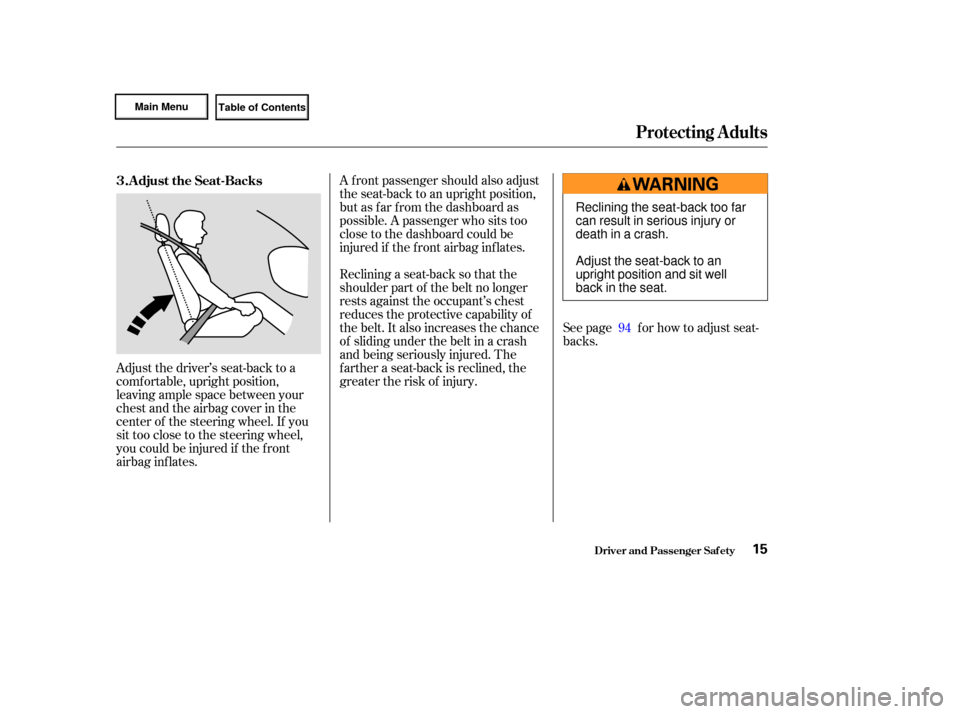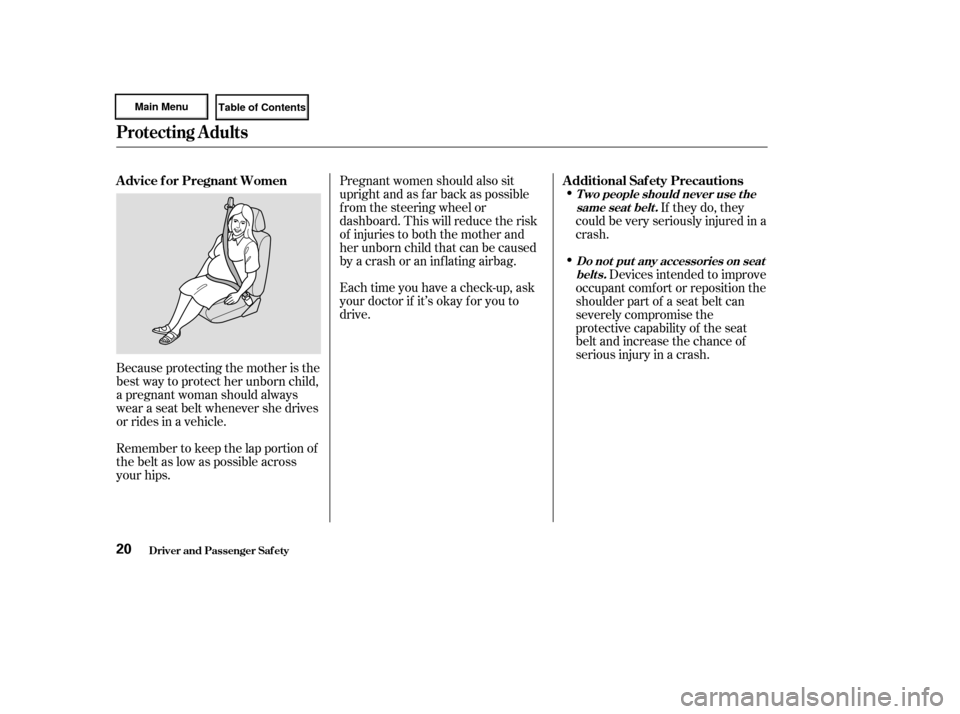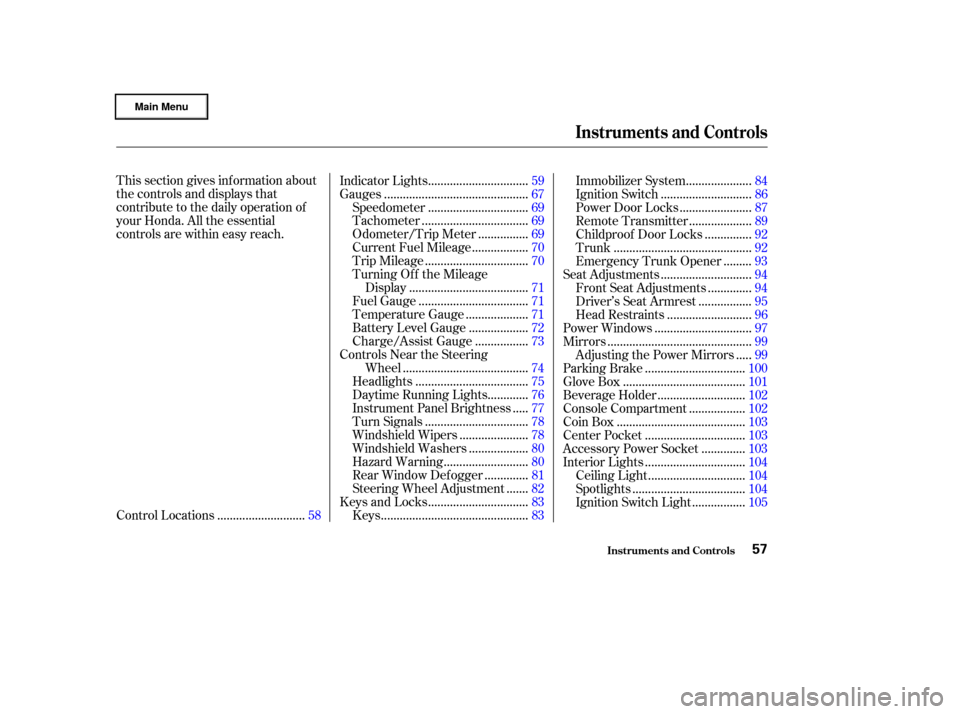Page 18 of 317

See page f or how to adjust seat-
backs.
A f ront passenger should also adjust
the seat-back to an upright position,
but as f ar f rom the dashboard as
possible. A passenger who sits too
close to the dashboard could be
injured if the f ront airbag inf lates.
Reclining a seat-back so that the
shoulder part of the belt no longer
rests against the occupant’s chest
reduces the protective capability of
the belt. It also increases the chance
of sliding under the belt in a crash
and being seriously injured. The
farther a seat-back is reclined, the
greater the risk of injury.
Adjust the driver’s seat-back to a
comf ortable, upright position,
leaving ample space between your
chest and the airbag cover in the
center of the steering wheel. If you
sit too close to the steering wheel,
you could be injured if the f ront
airbag inflates. 94
Adjust the Seat-Backs
3.
Protecting Adults
Driver and Passenger Saf ety15
Reclining the seat-back too far
can result in serious injury or
death in a crash.
Adjust the seat-back to an
upright position and sit well
back in the seat.
Page 21 of 317
Adjust the steering wheel, if needed,
so that the wheel points toward your
chest, not toward your f ace.
Pointing the steering wheel toward
your chest provides optimal
protection f rom the airbag.
See page f or how to adjust the
steering wheel.
If a seat belt does not seem to work
as it should, it may not protect the
occupant in a crash.
Anyone using a seat belt that is
not working properly can be
seriously injured or killed. Have your
Honda dealer check the belt as soon
as possible.
See page f or additional
inf ormation about your seat belt
system and how to take care of your
belts.
This could cause
very serious injuries in a crash.
45
82
A djust the Steering Wheel
6.
No one should
sit in a seat wit h an inoperat ive seat belt.
Never place t he shoulder port ion of a
lap/shoulder belt under your arm orbehind your back.
Driver and Passenger Saf ety
Protecting Adults
18
Page 23 of 317

Because protecting the mother is the
best way to protect her unborn child,
a pregnant woman should always
wear a seat belt whenever she drives
or rides in a vehicle.
Remember to keep the lap portion of
the belt as low as possible across
your hips.Pregnant women should also sit
upright and as f ar back as possible
f rom the steering wheel or
dashboard. This will reduce the risk
of injuries to both the mother and
her unborn child that can be caused
by a crash or an inf lating airbag.
Each time you have a check-up, ask
your doctor if it’s okay f or you to
drive.
If they do, they
could be very seriously injured in a
crash.
Devices intended to improve
occupant comf ort or reposition the
shoulder part of a seat belt can
severely compromise the
protective capability of the seat
belt and increase the chance of
serious injury in a crash.
Advice f or Pregnant Women
Additional Saf ety Precautions
T wo people should never use t he
same seat belt .
Do not put any accessories on seatbelts.
Protecting Adults
Driver and Passenger Saf ety20
Page 24 of 317

Carrying hard or sharp
objects on your lap, or driving with
a pipe or other sharp object in
your mouth, can result in injuries
if your f ront airbag inf lates.
Any object
attached to or placed on the covers
marked ‘‘SRS AIRBAG’’ in the
center of the steering wheel and
on top of the dashboard could
interf ere with the proper operation
of the airbags. Or, if the airbags
inf late, the objects could be
propelled inside the car and hurt
someone. If your
hands or arms are close to the
airbag cover in the center of the
steering wheel or on top of the
dashboard, they could be injured if
the front airbag inflates. If a side airbag
inflates,acupholderorotherhard
object attached on or near the
door could be propelled inside the
car and hurt someone.
Do not place hard or sharp object s
bet ween yourself and a f rontairbag.
Do not at t ach or place object s onthe f ront airbag covers. K eep your hands and arms away
f rom t he airbag covers.
On U.S. models wit h side airbags,
do not at t ach hard object s on ornear a f ront door.
Protecting Adults
Driver and Passenger Saf ety21
Page 51 of 317

Your Supplemental Restraint System
(SRS) includes:Two f ront airbags. The driver’s
airbag is stored in the center of
the steering wheel; the f ront
passenger’sairbagisstoredinthe
dashboard. Both are marked ‘‘SRS
AIRBAG.’’ A sophisticated electronic system
that continually monitors and
records inf ormation about the
sensors, the control unit, the
airbag activators, and driver and
passenger seat belt use when the
ignition is ON (II).
Sensors that can detect a
moderate to severe frontal
collision. Automatic seat belt tensioners
(see page ). An indicator light on the
instrument panel that alerts you to
a possible problem with the
system (see page ).
Emergency backup power in case
your car’s electrical system is
disconnected in a crash.
If you ever have a moderate to
severe f rontal collision, the sensors
will detect the vehicle’s rapid
deceleration. If the rate of
deceleration is high enough, the
control unit will instantly inf late the
f ront airbags. Your vehicle is equipped with dual-
stage, dual-threshold airbags to help
reduce the chance of airbag-caused
injuries.
51
46
SRS Components
How Your Front A irbags Work
Additional Inf ormation About Your Airbags
Driver and Passenger Saf ety48
Page 60 of 317

This section gives inf ormation about
the controls and displays that
contribute to the daily operation of
your Honda. All the essential
controls are within easy reach............................
Control Locations .58 ...............................
Indicator Lights .59
.............................................
Gauges .67
...............................
Speedometer .69
.................................
Tachometer .69
...............
Odometer/Trip Meter . 69
.................
Current Fuel Mileage . 70
................................
Trip Mileage .70
Turning Of f the Mileage .....................................
Display .71
..................................
Fuel Gauge .71
...................
Temperature Gauge . 71
..................
Battery Level Gauge . 72
................
Charge/Assist Gauge . 73
Controls Near the Steering .......................................
Wheel .74
...................................
Headlights .75
............
Daytime Running Lights . 76
....
Instrument Panel Brightness . 77
................................
Turn Signals .78
.....................
Windshield Wipers .78
..................
Windshield Washers . 80
..........................
Hazard Warning .80
.............
Rear Window Def ogger . 81
......
Steering Wheel Adjustment . 82
...............................
Keys and Locks .83
..............................................
Keys .83 ....................
Immobilizer System . 84
............................
Ignition Switch .86
......................
Power Door Locks .87
...................
Remote Transmitter . 89
..............
Childproof Door Locks . 92
...........................................
Trunk .92
........
Emergency Trunk Opener . 93
............................
Seat Adjustments .94
.............
Front Seat Adjustments . 94
................
Driver’s Seat Armrest . 95
..........................
Head Restraints .96
..............................
Power Windows .97
.............................................
Mirrors .99
....
Adjusting the Power Mirrors . 99
...............................
Parking Brake .100
......................................
Glove Box .101
...........................
Beverage Holder .102
.................
Console Compartment . 102
........................................
Coin Box .103
...............................
Center Pocket .103
.............
Accessory Power Socket . 103
...............................
Interior Lights .104
..............................
Ceiling Light .104
...................................
Spotlights .104
................
Ignition Switch Light . 105
Instruments and Controls
Inst rument s and Cont rols57
Page 62 of 317
�Î
�Î
�Î
The U.S. instrument panel is shown. Dif f erences f or the Canadian models are noted in the text.CONT INUED
Indicator L ights
Inst rument s and Cont rols
Automatic Transmission (CVT)
59
HIGH BEAM INDICATOR
(P.
64)
CRUISE CONTROL INDICATOR
(P. 65)
SEAT BELT REMINDER LIGHT
(P. 61)
SIDE AIRBAG CUTOFF INDICATOR
(P. 61)
SUPPLEMENTAL RESTRAINT
SYSTEM INDICATOR
(P. 61)
CHARGING SYSTEM
INDICATOR
(P. 62, 272)
AUTO IDLE STOP
INDICATOR
(P. 172)
IMMOBILIZER SYSTEM INDICATOR
(P. 63)
MALFUNCTION INDICATOR LAMP
(P. 273)
LOW OIL PRESSURE INDICATOR
(P.62, 271)
(P.63)
ELECTRIC POWER STEERING (EPS) INDICATOR (P.
166)
SHIFT LEVER POSITION
INDICATOR
(P.
65)
TRUNK-OPEN INDICATOR (P.
63)
IMA SYSTEM
INDICATOR
(P.
65)
LOW FUEL INDICATOR
ANTI-LOCK BRAKE SYSTEM
INDICATOR
(P.
62)
(P.
66)
MAINTENANCE REQUIRED INDICATOR
(P.
62)
PARKING BRAKE AND BRAKE SYSTEM
INDICATOR
Page 63 of 317
�Î
�Î
�Î
�Î
The U.S. instrument panel is shown. Dif f erences f or the Canadian models are noted in the text.
Indicator L ights
Inst rument s and Cont rols
Manual Transmission
60
HIGH BEAM INDICATOR
(P.
64)
(P. 65)
CRUISE CONTROL INDICATOR
SEAT BELT REMINDER LIGHT
(P. 61)
SIDE AIRBAG CUTOFF INDICATOR
(P. 61)
SUPPLEMENTAL RESTRAINT
SYSTEM INDICATOR
(P. 61)
CHARGING SYSTEM
INDICATOR
(P. 62, 272)
AUTO IDLE STOP
INDICATOR
(P. 164)
IMMOBILIZER SYSTEM
INDICATOR
(P. 63)
MALFUNCTION INDICATOR LAMP
(P. 273)
LOW OIL PRESSURE INDICATOR
(P. 62, 271)
(P.63)
ELECTRIC POWER STEERING (EPS)
INDICATOR SHIFT UP/SHIFT DOWN
INDICATORS
(P.165) TRUNK-OPEN INDICATOR
(P.
65) IMA SYSTEM
INDICATOR
(P.
63)
(P.
65)
LOW FUEL INDICATOR
ANTI-LOCK BRAKE SYSTEM
INDICATOR
(P.
62)
MAINTENANCE REQUIRED
INDICATOR
(P.
66)
(P.
62)
PARKING BRAKE AND BRAKE SYSTEM
INDICATOR